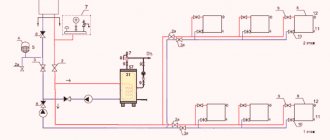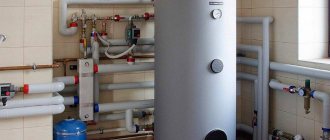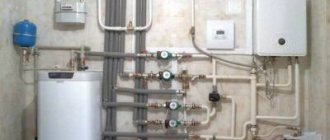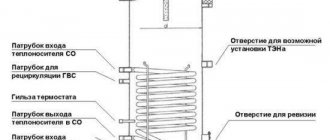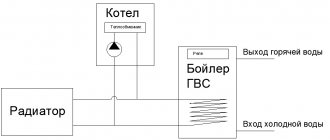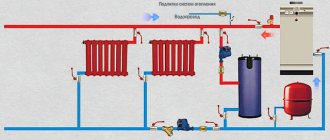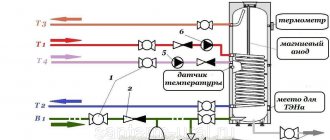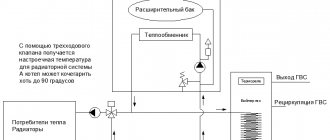Closed type with natural circulation
It is also a fairly simple piping scheme with a small number of heat consumers.
The scheme is very similar to the open type. It is distinguished by the inclusion of a closed expansion tank with a membrane, which is installed on the return pipe. In addition, do not forget about the security group. Some models are already equipped with it in production. The expansion tank is designed for a volume of more than 10% of the total coolant volume.
There are several important points when lining a heating boiler with polypropylene. The pipe from the heat generator to the safety group is made of metal, then it is laid from polypropylene. Also, the section of the return pipe with an installed three-way valve and sensor is made of metal. Polypropylene has low thermal conductivity. If you install a three-way valve on it, it will respond with a delay to an increase in temperature, and the sensor will provide information incorrectly.
In general, the polypropylene piping system for a heating boiler is beneficial and quite practical.
The nuances of installing and tying the device
It is best to wire the water heater together with the installation of the boiler and other equipment, rather than embed the device into a ready-made system. There are two basic connection principles:
- With priority . This scheme requires a powerful boiler. It provides rapid heating of the tank contents by pumping the entire volume through the coil. This way, hot water enters the radiators, which prevents the temperature from dropping.
- No priority . It is characterized by prolonged heating, since not all water passes through the coolant.
Tying rules:
- Choose a place to install the tank as close to the boiler as possible. This way you can reduce heat loss.
- Installation must be carried out on a flat and durable surface.
- For normal operation of the system, an expansion tank must be installed at the outlet of the water heater. It neutralizes thermal expansion.
- Each individual device (circuit) must be equipped with taps. This will allow you to turn them off individually, regardless of the rest of the system.
- Installation of a check valve is required.
- To reduce water hardness, install purification filters.
- Do not place tanks larger than 150 liters on the wall, especially if it is made of plasterboard.
Installation with electric or gas unit
Two heat generators can be installed in one heating system, the main one is a solid fuel unit, and the additional one is a boiler running on gas or electricity. This option is convenient because at night you can turn on the boiler, which operates in automatic mode. Gas in cylinders is inconvenient to use as the main energy carrier due to the need to take care of regular fuel supplies. Electricity is the most expensive energy source and it is most profitable to operate such a boiler unit only at night if the region has a system of cheap night tariffs.
How to connect solid fuel and gas boilers into one heating system for a large house? The simplest option is to connect two heat generators in parallel through a heat accumulator, which will additionally serve as a hydraulic separator.
The gas boiler operates in standby mode while the water in the buffer tank is heated by the solid fuel unit. After the fuel burns out, the coolant begins to cool, and as soon as the temperature sensor transmits the corresponding signal to the gas unit controller, it automatically turns on. When a solid fuel heat generator is restarted, the reverse process occurs - heating the coolant above a certain temperature leads to the gas burner turning off.
A system with an electric boiler in large houses is installed according to a similar principle. But for small private houses, a simpler and cheaper option for connecting a TT and an electric boiler is relevant (see diagram).
Connection diagram for solid fuel boiler and electric boiler
Boiler units are connected in parallel with the installation of check valves at each outlet. The electric boiler is equipped with a built-in circulation pump, which cannot be turned off, so for a solid fuel heat generator it is necessary to select a more powerful pump so that the TT boiler has an advantage over the electric one when operating together.
The system is being supplemented
:
- a thermostat that turns off the boiler’s TT circulation pump when the coolant cools down;
- a room temperature sensor, which turns on the electric boiler when the room temperature drops after the fuel burns out in the TT unit.
Method of primary and secondary rings
How to connect two boilers into one system using a minimum amount of electronics? The use of the method of primary and secondary circulation rings allows for joint piping of the CT of the unit and the electric boiler. Hydraulic separation of flows is carried out without installing a hydraulic arrow.
Option for connecting two types of boilers to one heating system
Both boilers, the DHW boiler, as well as all heating circuits, are connected by both supply and return pipelines to a single circulation ring - they are the primary one. The minimum pressure drop is ensured by the small distance between each pair of connections (no more than 300 mm). The pressure of the pump installed on the main circuit ensures the movement of the coolant along the primary ring, while the flow intensity is not affected by the pumps of the secondary circuits (to which heat consumers are connected).
For the system to function properly, it is necessary to perform complex hydraulic calculations and select the optimal pipeline diameter for all circuits
It is also important to calculate the pump performance. The actual performance of the pumping unit on the main circuit must exceed the coolant flow rate on the most “volumetric” secondary circuit
Both boilers are equipped with shut-off thermostats so that they can operate instead of each other.
Features of the operation of a solid fuel boiler
Like any other equipment, this type of heater has its pros and cons.
Positive sides:
- They do not require connection to the power supply network, that is, they are considered autonomous systems.
- Affordable price of equipment.
Taking into account the low cost of fuel, the use of this type of boiler is considered economically feasible.
The disadvantages include the following:
- Fire protection of surfaces adjacent to the unit is required.
- Controlling the combustion process is quite complex.
- Lack of automatic fuel supply, although this issue can be resolved if desired.
- It is advisable to ensure low humidity in the room where solid fuel is stored.
The principle of operation of TTKO is simple: when burned in a firebox, firewood or other raw materials release a certain amount of heat, which, in turn, heats the water circulating in the pipelines. The combustion products formed in this case are removed from the equipment through special devices: gases - through the chimney, the mineral part (ash and soot) - through the ash pan and soot collector.
Types of strapping
By piping an indirect heating boiler we mean connecting the pipelines of the boiler itself with the water supply. The operation of the system as a whole depends on how the installation is carried out.
Piping with servo drive and three-way control valve
This is the easiest way to tie. It is used when a large amount of water is consumed.
The boiler is connected to the main circuit and an additional one. The first is used to distribute heat into the batteries, the second circuit heats the water in the boiler itself. For proper flow separation, a three-way distribution valve is connected.
The thermostat monitors the temperature of the water in the tank, and when it reaches a predetermined value, a signal is sent to the servo drive. And it already sends a flow of heated water to the main circuit for heating. If the water temperature drops again, a switch will occur in the opposite direction and the coolant will return to the coil.
Trim with two pumps
Another piping option is with the parallel use of two pumps. One is mounted on the heating circuit, the other on the hot water supply. The control of the pumps, as in the first case, is entrusted to the thermostat. It is he who switches the operating mode.
Trim with hydraulic boom
If the heating system has many branches, such as a multi-circuit battery system or a separate branch for a heated floor, then it makes sense to use this type of piping. To avoid difficulties with a system in which each circuit is equipped with its own recirculation pump, a hydraulic distributor is used.
Coolant recirculation
If hot water is needed as quickly as possible, then it would be more correct to use a recirculation system. Due to the fact that a ring coolant line is formed in the system. The constant movement of water through it leads to heating. That is why the waiting time for hot water is reduced to a minimum.
To ensure continuous movement of water, a recirculation pump is installed in such a system. This hot water flow must be installed so that it passes through installations that constantly need heating. A heated towel dryer is an example of such a device.
Installation
High-quality piping of a boiler connected to a double-circuit boiler involves connecting the water heater to one of the heat exchangers. A ring system is formed when the boiler inlet pipe communicates with the initial link of the heat exchanger. Everything is designed in such a way that the water coming from the water supply bypasses the boiler heat exchanger. It will go straight into the boiler, and from there it will penetrate into the hot water supply line. You can connect an electric boiler using approximately the same scheme, but the water supply is connected to the first pipe of the second unit that exchanges heat, and the second pipe is already connected to the boiler.
It is recommended to install the water heater as close as possible to the energy source in order to simplify their connection using automation. When the device is mounted, it is time for docking. Important: a properly installed and connected water heater must only take a certain amount of heat. Excessively high consumption can paralyze the heating system. This problem can most often be solved by installing an automatically controlled circulation pump with your own hands or with the help of professionals.
Only the very last step is to install the thermal block. It is almost always recommended to have the circuit assembled by a professional. The nuance is that indirect heating boilers with a control unit must be connected exclusively to heating systems that receive water from uncontrolled boilers.
All you need is:
- tighten up the serving and taking moves;
- connect the storage tank to the water supply;
- place a comb distributing hot water on the upper outlet;
- Fill the reservoir and begin warming up immediately.
The simplest boilers interact mainly with automated heat sources. During installation, you will have to take care of connecting a sensor that measures the heating force. This sensor is supposed to be connected to a strictly defined input into the boiler. It is possible to connect boilers independent of the electrical network to autonomous boilers, but this immediately complicates the work and requires a special circuit. It should be borne in mind that it is possible to heat the water inside the boiler a little lower than the heated liquid in the coil.
Therefore, when the boiler is switched to low heating mode and can supply coolant heated to 40 degrees, only combined type heaters can raise the temperature higher. They always include an electric heating element to help add heat. If, when setting up a system that controls recirculation, priority is given to heating hot water in the tap, the movement of the entire coolant is directed through the storage exchange unit. As a result, the total time spent on obtaining liquid at the required temperature is noticeably reduced.
As practice shows, if boiler room designers and installers give preference to the option with priority, it is possible to provide comfortable conditions for residents. To warm up the entire volume of liquid in the tank, it should take from 20 to 40 minutes.
And if we talk about stabilizing the temperature against the background of coolant consumption, this time is reduced several times more. Even a small dwelling is unlikely to have time to cool down enough for it to be detected by those in it. But a lot depends on the installed boiler and boiler: their power must match, and ideally it is recommended to install a boiler with a power reserve of 25%.
To ensure stable operation of devices connected to combs that distribute hot water, it is necessary to supplement the outlet from the boiler with a special expansion tank. The recommended value is 10% of the main tank, helping to absorb the effects of thermal expansion. All connected branches must be equipped with ball-type shut-off valves. With their help, any node can be disconnected from the main line at the right time and checked or repaired.
The pipelines through which the liquid is supplied are usually equipped with check valves. With their help, the opposite flow of the coolant is prevented, and the convenience and safety of installation is increased. It may be necessary to place a boiler near the boiler, on the supply side of which a pump is mounted to provide circulation. In this option, it is very important to provide a separate circuit through which water will flow into the heater from the boiler. Essentially, a parallel type of connection is created.
If there is a pump in both the boiler and the boiler, a three-way valve must be mounted immediately behind the circulation pump; one channel is connected to the water heater pipe. This ensures normal heating operation. A tee must be installed on the return pipe up to the point where it enters the boiler. And this tee is connected to a pipe that draws liquid from the heat exchanger. Such a simple system easily and elegantly solves the problems.
As soon as the sensor signals that the coolant temperature has dropped below the set point, the valve transfers fresh flow to the boiler. The heating system stops. When the normal value is restored, the same valve switches back. The minimum number of components reduces the risk of breakdown. And the simplicity of execution allows you to quickly find a problem if it does appear.
When a grid-independent boiler is used, ensuring boiler priority is not as easy to achieve as in other options. It is recommended to install the water heater higher in relation to the floor of the room than the radiators. It is advisable that the lowest point of the wall model is also raised above the boiler. But it is possible to strictly comply with such a requirement only in individual cases. When it is partially executed, it is still worth raising the drive to as high a height as possible.
By placing the boiler on the floor, the rate of heating of the liquid is immediately reduced. What’s even worse is that the lower part of the container is basically unable to warm up normally in this mode. If you connect the boiler using the classical system, then any power outage will deprive you of access to hot water. The problem can be solved by using a larger pipe for the circuit connected to the water heater than on the heating link. Immediately at the beginning of the heating branch, a thermostat head is placed and a sensor is applied. Energy is provided by batteries.
Without constant recirculation, systems that contain a water heated towel rail cannot operate. The benefit of such a circuit is that water flows instantly when you open a hot tap. But the total consumption increases, and the efficiency of the system comes into question. To make matters worse, recirculation creates the problem of mixing dissimilar layers of liquid. However, since it has been decided to use a heated towel rail on water, this is the only possible choice.
By choosing Protherm indirect type boilers, you can combine them into one system with gas or electric-powered single-circuit boilers of the Skat models. The popularity of water heaters connected to a solar collector is also growing. This solution allows you to provide yourself with both heat and hot water at minimal cost even in winter. The single-circuit option involves placing the collector under the tank, and the tank itself communicates hydraulically with the lower branch pipe of the collector and with the upper outlet from it.
Video - How to connect a KN boiler to a single-circuit boiler
Piping the boiler with a buffer tank
Many manufacturers strongly recommend using a heat accumulator. A boiler buffer tank is used for the following reasons:
- When the air damper is closed in the chamber, wood smoldering occurs with insufficient oxygen, and this leads to an increase in the proportion of carbon monoxide (CO) in combustion products and increased environmental pollution. Therefore, a solid fuel boiler must operate at medium or full power, accumulating excess heat in the accumulator tank.
- After the firewood burns out and the firebox goes out, the energy contained in the storage tank will be enough to heat the house for some time. The duration of this period of time depends on the volume of the tank.
The figure shows a diagram of the piping of a solid fuel boiler with a battery tank, a small circulation circuit and two mixing units. The arrows on it show the coolant circulation.
An alternative to the previous connection methods is to connect a solid fuel boiler with a buffer tank (hydraulic arrow). The connection diagram is somewhat reminiscent of the previous one, with the difference that the hydraulic arrow does not serve as a heat accumulator, but is intended for hydraulic separation of the boiler circuit with the rest of the heating branches. There can be many of the latter: radiator heating, heated floors, indirect water heating boiler for domestic hot water. In this case, the temperature of the coolant in each branch needs to be different. Below is a diagram of connecting a solid fuel boiler with a buffer tank and a distribution manifold to a boiler and radiator heating system.
1 – heat generator; 2 – temperature sensor; 3 – three-way valve of the boiler circuit; 4 – membrane expansion tank; 5 – buffer capacity; 6 – radiators; 7 – heating circuit circulation pump; 8 - three-way valve of the heating circuit; 9 – room thermostat; 10 – indirect heating boiler; 11 - circulation pump of the DHW heating circuit; 12 – security group.
Varieties of heating schemes for a private house
In the simplest version of the boiler diagram, there is no piping at all. In the vast majority of cases, the factory equipment of boilers with electronic ignition consists of the following elements: a pump, an expansion tank, an automatic vent and a valve (with a pressure setting of 2.5 kgf/cm2). The location of all piping units is the building: as a result, the complex is transformed into a mini-boiler room.
As additional elements, the system can be equipped with:
- Filter. Its installation location is the inlet pipe. As a result, the heat exchanger receives protection from contamination while increasing the hydraulic resistance of the circuit. This leads to a decrease in the speed of movement of the coolant, and the pump itself experiences additional load.
- Ball valves. They are installed at the inlet and outlet sections. This makes it possible to dismantle the heat exchanger or boiler while maintaining the heating circuit.
Trim option with buffer tank
The presence of a buffer tank is extremely desirable for the operation of a boiler using solid fuels and here’s why. In order for the unit to function efficiently and produce heat with the efficiency declared in the passport (from 75 to 85% for different types), it must operate at maximum mode. When the air damper is closed to slow down combustion, there is a lack of oxygen in the firebox and the efficiency of wood burning decreases. At the same time, emissions of carbon monoxide (CO) into the atmosphere increase.
For reference. It is because of emissions that in most European countries it is prohibited to operate solid fuel boilers without a buffer tank.
On the other hand, at maximum combustion, the temperature of the coolant in modern heat generators reaches 85 ° C, and one load of firewood lasts only 4 hours. This does not suit many owners of private houses. The solution to the problem is to install a buffer tank and connect it to the TT boiler piping so that it serves as a storage tank. Schematically it looks like this:
By measuring the temperatures T1 and T2, you can configure the layer-by-layer loading of the container with a balancing valve
When the firebox is burning with all its might, the buffer tank accumulates heat (in technical language, it is loaded), and after extinguishing it releases it into the heating system. To control the temperature of the coolant supplied to the radiators, a three-way mixing valve and a second pump are also installed on the other side of the storage tank. Now it is not at all necessary to run to the boiler every 4 hours, because after the firebox goes out, the heating of the house will be provided for some time by the buffer tank. How long depends on its volume and heating temperature.
For reference. Based on practical experience, the capacity of a heat accumulator can be determined as follows: for a private house with an area of 200 m², you will need a tank with a volume of at least 1 m³.
There are a couple of important nuances. In order for the piping circuit to work safely, you need a solid fuel boiler whose power is sufficient for simultaneous heating and loading of the buffer tank. This means that power is needed 2 times higher than the calculated one. Another point is to select the pump performance so that the flow rate in the boiler circuit is slightly higher than the amount of water flowing in the heating circuit.
An interesting option for connecting a TT boiler with a homemade buffer tank (aka an indirect heating boiler) without a pump was demonstrated by our expert in the video:
Rules for operating the system
An indirect heating boiler is a complex and expensive piece of equipment; therefore, its installation, adjustment and first commissioning should be carried out by a special service organization, especially if the BKN is under warranty service. During the first start-up, the service organization must also instruct the owner of the equipment on the operating rules.
After completing the installation work, first of all, the BKN is connected to the heating circuit, along the coolant and hot water lines, and the tank is filled with tap water.
Before filling the working container, rinse the internal heating surfaces with ordinary tap water, opening the vents until clean water comes out of them without air pockets.
After filling the boiler and releasing air, pressure testing is performed through the heating and heated pipeline system with a pressure of at least 1.25 of the working pressure, which is created using a circulation pump. When the required pressure is reached, check the system for leaks.
After the system has been checked for density, a single-circuit gas boiler is put into operation, the temperature of the heating fluid is raised and sent to the BKN circuit.
During the water heating process, the operation of the safety valve and expansion tank is monitored, and when the operating heating parameters are reached, the response parameters of the protection and control systems are monitored.
Basic principles for connecting a solid fuel unit
When considering how to properly connect a solid fuel boiler, you need to pay attention to the basic piping elements that ensure the safe operation of the heat generator. We are talking about the safety group and the mixing unit
The safety group, which includes a pressure gauge, as well as a safety valve and an air vent, mounted on one manifold, is installed directly on the outlet pipe of the boiler unit. The pressure gauge helps monitor the pressure in the system, the air vent serves to remove air pockets, and the safety valve releases excess steam-water mixture when the pressure exceeds the specified parameters.
A mixing unit based on a three-way valve with a thermal head is installed together with a bypass (jumper) connecting the supply and return pipes, thereby forming a small circulation circuit.
The system that protects the boiler from condensation and temperature shock operates according to the following scheme
:
- While the fuel flares up, the valve blocks the flow of cooled coolant from the large heating circuit. As a result, the circulation pump circulates a limited volume of coolant in a small circle.
- A sensor is installed on the return pipe, connected to the thermal head of a three-way valve. When the coolant in the return pipeline heats up to 50-55 degrees, the thermal head is activated and presses on the valve stem.
- The valve smoothly opens slightly and the cooled coolant begins to gradually flow into the boiler jacket, mixing with the heated coolant from the bypass.
- When all radiators warm up and the return temperature rises to values safe for the boiler, the three-way valve closes the bypass, completely opening the passage of coolant flow through the return pipeline.
The basic diagram for connecting a solid fuel boiler to the heating system is as simple and reliable as possible; you can install the piping yourself.
It is important to know how to connect a solid fuel boiler using polymer pipes to avoid common problems:
- It is unsafe to use polymer pipes for piping a boiler - they may not withstand an emergency increase in temperature and pressure. Therefore, it is recommended to make the piping with steel or copper, and connect the polymer pipes to the manifold that distributes the coolant through the heating circuits. As a last resort, a metal pipe is installed only between the boiler supply pipe and the safety group.
- The use of a thick-walled polypropylene pipe for the return pipeline in the area between the three-way valve and the boiler pipe leads to the fact that the surface-mounted temperature sensor responds to the heating of the coolant with a noticeable delay. It is better to install a metal pipe.
Connecting a solid fuel installation with a hydraulic boom
The pump for a heating system with forced supply of coolant is installed on the return pipe between the three-way valve and the boiler. This arrangement allows it to circulate water or antifreeze in a small circle. It is impossible to install the circulation pump on the supply pipe, since the device is not designed to work with a steam-water mixture that is formed when the coolant overheats. Stopping the pump will speed up or provoke an explosion of the heating boiler, since cooled coolant will no longer flow into it.
How to reduce the cost of harness
The basic connection diagram for a solid fuel boiler involves the use of a three-way mixing valve equipped with a thermal head and an overhead sensor. This equipment is quite expensive, and it can be replaced with a cheaper option - a three-way valve with a built-in thermostatic element. This device has a fixed setting - the valve is activated when the ambient temperature reaches 55 or 60 degrees (depending on the model).
Installing a valve that maintains a fixed temperature reduces the financial costs of installing protection for a solid fuel unit from condensation and thermal extremes. The ability to flexibly control the temperature of the coolant is lost; deviations from the set value can reach 1-2 degrees, but this is not critical.
Boiler selection
The volume of the boiler is determined by the power of the heating network in the house. Because it will take the main load while the device is operating. If the heater volume is larger than the system volume, the boiler may malfunction. Also, the temperature level in the heating equipment will be too low to warm the house. The volume of the indirect heater should not exceed forty percent of the total volume of liquid in the heating system so that performance does not suffer.
You need to consider the number of people in the family. A person needs up to eighty liters of water to take a shower. And two hundred liters of water are heated by a boiler in about six hours. Knowing these values, you should calculate the volume of the device so that it is enough for the needs of the family until new heating occurs.
Selection by material
It is important to pay attention to the material of the coil. Inexpensive models are equipped with a steel coil welded to the tank. In expensive devices, the tube is brass and removable
Brass is much higher quality than steel. Removable coil is easy to remove to clean out deposits
In expensive devices, the tube is brass and removable. Brass is much higher quality than steel. The removable coil is easy to remove to clean out deposits.
Tanks often develop leaks. Inexpensive boilers are enameled inside, but the material, due to the rapid formation of cracks due to temperature changes, can leak because the metal corrodes. The best option is to purchase a stainless steel tank. This option will cost more over a longer service life, because the magnesium anode can be replaced.
The material from which the insulation is made also affects the efficiency of the system. Foam rubber is often used, which is inferior in many positions. It is good to use polyurethane or other insulation materials as insulation.
Select by additional parameters
The boiler can be equipped with two heating sources, or have a heating element. From them it will heat the water when the heating in the house does not work. These devices are expensive, but practical.
Boilers can be wall-mounted or floor-mounted. It is selected according to the type of heating system. With a wall-mounted system, a wall-mounted boiler is chosen. Tanks with a volume of less than two hundred liters can be mounted on the wall.
Pros of boilers
The advantages of boilers of this type include:
1.Hot water obtained in this way has a low cost. No need to pay for electricity or gas. The load on the heating source is small. In winter, this type of boiler is considered relevant.
2. During the heating season, the load on the electrical network is reduced, since the operation is based on the energy of the boiler.
3.Can heat a large volume of water.
4. The boiler can provide water to several units at once.
5. Alternative heating sources can be used for heating.
6. The coolant does not interact with water, which is heated; liquid almost free of salt enters the coil.
Joint connection of two boilers
To increase the heating comfort of a private home, many owners install two or more heat sources that run on different energy sources. At the moment, the most relevant combinations of boilers are:
- natural gas and wood;
- solid fuel and electricity.
Accordingly, the gas and solid fuel boiler must be connected in such a way that the second automatically replaces the first after burning the next portion of firewood. The same requirements are put forward for connecting an electric boiler to a wood boiler. This is quite simple to do when a buffer tank is involved in the piping scheme, since it simultaneously plays the role of a hydraulic arrow, as shown in the figure.
As you can see, thanks to the presence of an intermediate storage tank, 2 different boilers can serve several heating distribution circuits at once - radiators and heated floors, and in addition load an indirect heating boiler. But not everyone installs a heat accumulator with a TT boiler, since this is not a cheap pleasure. In this case, there is a simple diagram, and you can install it yourself:
Note. The scheme is valid for both electric and gas heat generators operating together with solid fuel.
Here the main source of heat is a wood heater. After a stack of firewood burns out, the air temperature in the house begins to drop, which is registered by the room thermostat sensor and immediately turns on heating by the electric boiler. Without a new load of firewood, the temperature in the supply pipe decreases and the overhead mechanical thermostat turns off the pump of the solid fuel unit. If you ignite it after some time, everything will happen in the reverse order. This video is described in detail about this joint connection method:
Tying using the method of primary and secondary rings
There is another way to combine a solid fuel boiler with an electric one to supply a large number of consumers. This is a method of primary and secondary circulation rings, which provides for hydraulic separation of flows, but without the use of a hydraulic needle. Also, for reliable operation of the system, a minimum of electronics is required, and a controller is not needed at all, despite the apparent complexity of the circuit:
The trick is that all consumers and boilers are connected to one primary circulation ring by both the supply and return pipelines. Due to the small distance between connections (up to 300 mm), the pressure drop is minimal compared to the pressure of the main circuit pump. Due to this, the movement of water in the primary ring does not depend on the operation of the secondary ring pumps. Only the temperature of the coolant changes.
Theoretically, any number of heat sources and secondary rings can be included in the main circuit. The main thing is to choose the right pipe diameters and the performance of the pumping units. The actual performance of the main ring pump must exceed the flow rate in the most “gluttonous” secondary circuit.
To achieve this, it is necessary to perform a hydraulic calculation and only then will it be possible to select the right pumps, so an ordinary homeowner cannot do without the help of specialists. In addition, it is necessary to link the operation of solid fuel and electric boilers by installing shut-off thermostats, as described in the following video:
More about the boiler as an indirect heating device
Diagram of an indirect water heater.
A double-circuit boiler always works on only one of the circuits, which is a disadvantage that remains in the scheme of a single-circuit boiler with a boiler, but the boiler still compensates for some of the shortcomings of double-circuit boilers.
Thus, in a double-circuit boiler, water in the second circuit is heated in flow mode, and to achieve the required temperature it takes from 30 to 60 s, which leads to a certain loss of water. The boiler, in conjunction with a single-circuit boiler, is a heat accumulator and, like a thermos, retains it for a long time.
Related article: Do-it-yourself fabric blinds, easy and quick
Only an uninterrupted supply of gas or electricity and properly functioning primary heat sources can guarantee the normal operation of the DHW boiler. Boilers running on solid or liquid fuel are more reliable in this regard, since the amount of stored fuel must be calculated according to the required energy for heating the house, taking into account the hot water supply.
Providing hot water supply after the end of the heating season using the same heat source is impractical, if only because of its ineffective use, when a maximum of 50% of its installed capacity is sufficient. For this period of time, a wall-mounted gas boiler of low power, equipped with a heating element, should be provided. In addition, unlike powerful boilers, wall-mounted gas boilers have low inertia, which is useful for quickly heating water. The required power of the heating element only for heating domestic water will be significantly less. You can also purchase a boiler with a heating element installed in it.
Emergency options
Every piping scheme must include a circuit in case of emergency situations. His task includes:
— protection against pressure drops;
— protection against temperature increases above the permitted limit;
— prevention of moisture formation.
Safety valve in the harness
Its task is precisely to relieve excess pressure from the system. It is mounted at the boiler outlet separately or as part of a safety group.
Emergency heat exchanger in the solid fuel boiler connection system
Its task is most responsible - to prevent overheating of both the boiler and the system in general. Overheating can happen for 2 reasons:
— too much fuel was loaded into the boiler. The heat received exceeded the demand.
— the electricity was turned off and the pump stopped working.
For normal operation of this circuit, it is also necessary to install a temperature sensor with a valve and a cooling unit in the water supply pipe to the boiler. As soon as the coolant temperature exceeds the maximum allowed, the sensor signals this and provokes the opening of the valve.
After the valve is activated, water begins to fill the cooling unit, reducing the temperature of the main coolant.
Auxiliary heating circuit for a solid fuel boiler
One of the options for cooling the system. Its peculiarity is that you will need to connect a storage tank for the DHW circuit.
This scheme will work as follows: in normal operating mode, the pump will operate, creating a certain pressure. It will prevent the auxiliary circuit from coming into operation. But as soon as the electricity is turned off, the pump will stop working, the pressure will disappear, and the backup circuit will come into operation.
Result: the water temperature in the system will drop to the desired value.
Let’s say right away that this scheme is suitable for absolutely any type of heating system!
This mixer maintains the lowest temperature of the coolant at the inlet to the boiler so that condensation does not form on the walls of the device. what we talked about at the very beginning of the article. Thus, in a solid fuel boiler this is one of the most necessary components!
The mixer is installed on the return pipe using a bypass.
If the temperature in the return pipe is low (below the set value), the thermomixer will provide an influx of hot water.
Features of installing a flow-through pressure boiler
In contrast to non-pressure brands, pressure electric water heaters can provide DHW to several water points at the same time. Therefore, they are placed in places of maximum water consumption.
Similarly, any water heater will need to supply tap water from the apartment wiring to the inlet, and connect a flexible sanitary hot water hose to the outlet pipe.
The peculiarities of the placement of these modifications are reliable electrical wiring with a reserve, otherwise, when the hot water supply is heated, the machines will turn off.
Due to their significant power, experts advise that pressure water heaters be connected directly to the electrical panel through a differential circuit breaker corresponding to the current rating and using a 3-core cable with a cross-section of at least 6 mm2.
Why do you need a buffer tank for a TT or electric boiler?
- after the TT boiler is turned off due to burning of wood or coal, at night, heating of the building continues;
- overheating and boiling of the coolant (a common occurrence during the operation of a high-pressure boiler) is eliminated;
- when installing a storage tank with a DHW circuit, you can provide hot water supply to your home;
- a tank with two heat exchangers can be simultaneously connected to a boiler, hot water supply system and solar collectors or geothermal pump.
In the case of parallel connection of an electric and solid fuel boiler into a single heating network, the storage tank plays the role of a heat accumulator and a hydraulic separator.
| Living area / battery life | 8 o'clock | 10 o'clock | 12 o'clock | 14 o'clock | 16 o'clock |
| 100 m² | 587 l | 734 l | 881 l | 1028 l | 1175 l |
| 150 m² | 880 l | 1101 l | 1321 l | 1542 l | 1762 l |
| 200 m² | 1174 l | 1468 l | 1762 l | 2056 l | 2350 l |
How to connect an indirect heating boiler to a single-circuit boiler
Fittings for tying BKN
- ensure continuous circulation of coolant from the boiler to the water heater;
- prevent hydraulic and thermal shock;
- maintain the set water heating temperature in automatic mode.
- Membrane expansion tank - designed to compensate for thermal expansion in the hot water system and prevent emergency situations. When connected, the BKN is installed together with the security group. The expansion tank must contain at least 10% of the total volume of the indirect heating boiler.
- Safety valve - needed for emergency drainage of water from the BKN. If the pressure increases excessively, it opens and releases water from the boiler. The valve is used during maintenance to fill the storage tank with chemical reagents that eliminate scale.
- Safety group for an indirect heating boiler - includes a pressure gauge, relief valve and air vent. The unit is designed to normalize pressure in the hot water supply and prevent water hammer. Installation of the safety group and expansion tank is a requirement set by manufacturers for the BKN piping.
- Boiler temperature sensor - connects to the circulation pump that controls the pressure in the coil. An immersion thermostat operates on the relay principle. When sufficient water heating is achieved, the sensor gives a signal to turn off the pumping equipment. The water stops heating. After cooling, the boiler automation starts circulation.
- Three-way valve - works as a mixing unit, opening and closing the flow of water to the boiler from the heating system. There are simple mechanical devices and precision servo-actuated three-way valves.
- Circulation pump - depending on the selected piping scheme, one or two modules are installed. The pump is used to create constant pressure and recirculation in the DHW system.
Pipe material for piping BKN
- Cold water - a regular polypropylene pipe can be installed. The material is suitable for soldering the entire cold water supply system.
- Hot water supply - the temperature of the hot water supplied to the user is maintained at 65-70°. It is allowed to use polypropylene with fiberglass (reinforced) or aluminum reinforcement intended for hot water supply. Another option: piping with copper pipe. When laying copper pipes, it is necessary to use thermal insulation. Copper is a good thermal conductor, which will inevitably lead to a decrease in the temperature of heated water during transportation to the end consumer. Thermal insulation of pipes will protect against heat loss.
Options for piping an indirect heating boiler
Another important factor taken into account when choosing a connection type is volatility. There are gravity systems in which water and coolant circulate independently, as well as schemes with the creation of forced pressure (pumping). The latter cannot work without electricity. BKN manufacturers indicate in the operating instructions the recommended wiring diagram, which is also taken into account when connecting.
- fast heating of hot water supply;
- savings with constant use of the boiler;
- Possibility of automating water heating.
Tying in a gravity system
Installation of DHW recirculation with BKN
- reducing the DHW heating temperature;
- increased fuel costs;
- energy dependence.
BKN piping with a double-circuit boiler
- When the tap is opened, the double-circuit boiler heats the DHW heat exchanger, spending the maximum amount of thermal energy on this. It takes time for the coil to warm up. For this reason, hot water does not flow to the user immediately after opening the tap, but after some time (the period depends on the distance to the water collection point and the power of the boiler).
- Frequent starts and stops of hot water supply place a load on the heating elements, which can lead to rapid equipment failure.
Connecting an indirect heating boiler: basic connection diagrams
There are only two principles for connecting such devices to boilers:
- with priority for hot water heating;
- without him.
In the first case, the entire heating system coolant is driven through the device’s coil. Heating in this case takes very little time. When using the second method, only part of the coolant is sent to the boiler coil. In this case, heating the water in the tank takes a long time.
Most often, in private homes, the technology of connecting boilers with priority for heating hot water is used. This allows you to make life in a country house more comfortable. In this case, the water is heated up faster, but the insertion of the boiler has virtually no effect on the operation of the heating system itself.
However, when using such a scheme, it is important to correctly select both types of equipment.
When using this technique, the boiler should have greater productivity than the boiler (by about 25-30%) Date: September 25, 2022
Power calculation and equipment selection
Initially, in order to select a BKNSR scheme and select equipment, it is necessary to calculate the thermal load on the domestic hot water supply for a specific consumer. An incorrectly selected connection method will lead to ineffectiveness of the DHW recirculation system or breakdown of the main and pumping equipment.
How to choose a boiler
For example, to perform the calculation, for a family of 4 people they take hot water standards according to SNiP 2.04.01-85 “Internal water supply and sewerage of buildings.”
Simple calculations show that washing dishes will require 336 l/week, showering - 1280 l/week, and minor activities another 280 l/week, for a total of 2856 l/week or 17 l/hour.
Formula for determining power:
17x0.0375=0.637kW
Heater design parameters:
- The minimum volume of water consumption is 1.5 l/min.
- Capacity volume - more than 100 liters.
- Water heating time is up to 2 hours.
- Thermal insulation material is polyurethane foam or mineral wool.
- Safety elements: valves, temperature and pressure sensors and fuses.
- Service life is from 10 to 12 years.
